#iromuji furisode
Text
Himeko - Refs - Other Stuff

Kichiya Knot:
Kimonos that use this style are:
- Everyday Kimono
- Iromuji
- Furisode
Bunko Knot:
Kimonos that use this style are:
- Yukata
- Usumono / Natsumono:
- Komon
- Cropped Kimono
Karuta Musubi / Card Knot:
Kimonos that use this style are:
- Autuam Kimono
- Tsukesage
- "Ball Gown" Kimono
Otaiko Musubi / Nagoya Obi:
Kimonos that use this style are:
- Winter Kimono
- Tsukesage
- Houmongi
- Irotomesode
Hitotu / Darari Masubi:
Kimonos that use this style are:
- Susohiki / Hikizuri
- "Evening Gown" Kimono
Double Bow Musubi:
Kimonos that use this style are:
- Bell Skirt Style Kimono
- Short Skirt Furisode

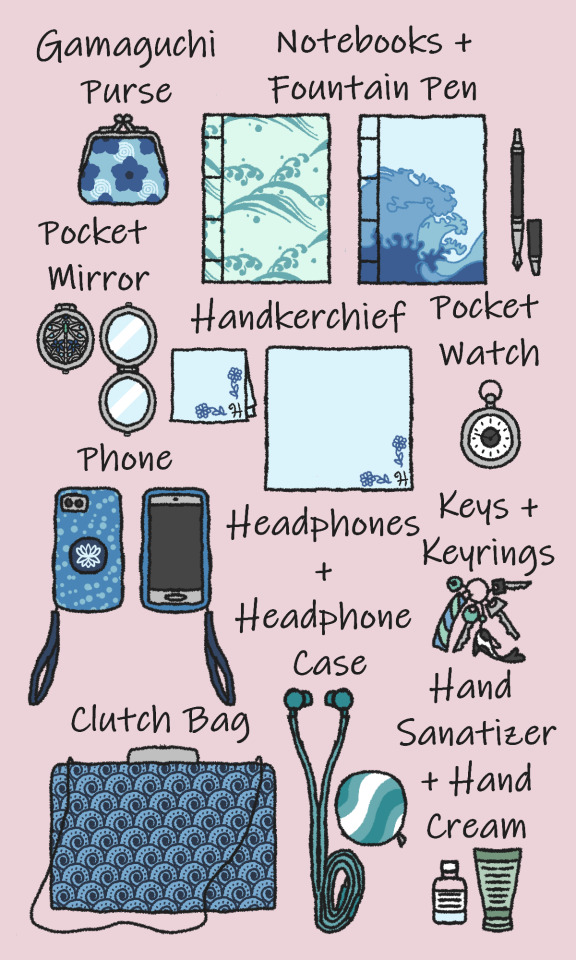
Left:
The following items hear Himeko has had since the Edo Period:
- Kinchaku Bag
- Coin Purse
- Hakoseko Pouch (for cosmetics)
- Kiseru Pipe + Tobacco Pouch
- Combs + Comb Boxes
- Hanko Set
- Sensu Fans + Fan Cases
- Uchiwa Fans
Right:
The following Items are ones Himeko has had since the Meiji Period
- Gamaguchi Purse
- Notebooks + Fountain Pen
- Pocket Watch
- Pocket Mirror
- Handkerchief
The following Items are ones Himeko has had in recent years (modern day)
- Phone
- Headphones + Headphone Case
- Keys + Keyrings
- Hand Sanitizer + Hand Cream
- Clutch Bag
#original#original character#ocs#oc#oc character#original design#character design#character art#fae#faerie#fae folk#fairies#fairy#Himeko#object design#item design
4 notes
·
View notes
Text
The Art of Kimono: Your Virtual Shopping Experience
In today's fast-paced world, shopping online has become a convenient way to access unique and exotic items. If you're intrigued by the idea of owning a kimono, you'll be pleased to know that there are numerous options available through a kimono shop online. In this article, we will explore the world of kimonos, their rich history, the different types you can find online, and how to choose the perfect one for you. We will also discuss the proper care of your kimono purchase.
The Fascinating History of Kimonos
Kimonos have a deep-rooted history in Japanese culture, spanning over a thousand years. Originally, they were worn by the Japanese elite, and the word "kimono" itself means "thing to wear." These garments represent both tradition and art, and they come in various designs and materials.
Types of Kimonos You Can Find Online
When you explore a kimono shop online, you'll discover a wide array of options. There are several types of kimonos to choose from, each with its unique characteristics:
Furisode: These are colourful, long-sleeved kimonos often worn by young, unmarried women. They feature vibrant patterns and are perfect for special occasions.
Houmongi: Houmongi kimonos are more formal and are adorned with intricate, all-over patterns. They are suitable for ceremonies and parties.
Yukata: Yukatas are casual, cotton kimonos often worn in the summer. They are comfortable and easy to care for, making them a popular choice for many.
Iromuji: These are plain kimonos with a single, solid colour. They are often chosen for tea ceremonies and other traditional events.
Komon: Komon kimonos have small, repeated patterns and can be worn for a wide range of occasions, from casual to semi-formal.
Choosing the Right Kimono for You
Selecting the perfect kimono depends on your personal style and the occasion. When shopping for a kimono online, consider the following factors:
Colour: Choose a colour that complements your skin tone and matches the event's formality.
Pattern: Decide whether you want a simple or elaborate design, and consider what appeals to your taste.
Material: Different kimonos are made from various materials, such as silk, cotton, or synthetic fabrics. Choose one that suits the climate and your comfort.
Size: Ensure you select the right size to guarantee a comfortable fit.
Caring for Your Kimono Purchase
Proper care of your kimono is essential to maintain its beauty and longevity. Follow these guidelines:
Dry Cleaning: Most kimonos require professional dry cleaning. Make sure to follow care instructions diligently.
Storage: Store your kimono in a cool, dry place, and keep it away from direct sunlight to prevent fading.
Wearing Accessories: Use appropriate accessories like an obi (sash) and undergarments to complete your kimono ensemble.
The Convenience of Shopping for Kimonos Online
The internet has made it more accessible than ever to explore and purchase kimonos. By shopping at a kimono shop online, you can browse through a vast selection, read reviews, and compare prices from the comfort of your own home. The convenience of online shopping allows you to make an informed decision and choose the perfect kimono for your needs.
The End
The world of kimonos is a rich and fascinating one, and the convenience of shopping online for these traditional garments is a boon for enthusiasts. Whether you're drawn to their history, cultural significance, or simply their beauty, a kimono shop online is the perfect place to start your journey into this captivating world. So, explore the options, consider your preferences, and embrace the beauty of owning your very own kimono.
0 notes
Text
Paradise!Inosuke AU: Kizurenka
Kizurenka
Name: Kizurenka
Kanji: 傷蓮香
Race: Human
Gender: Female
Age: 20
Height: 5’4 ¼” (163 cm), 5’9” (176 cm) [With Okobo]
Affiliation: Eternal Paradise Faith
Occupation: Teacher
Base of Operations: Paradise Faith Cult
Status: Alive
Relatives: Roku/Si-Woo (fiance)
Appearance: Kizunrenka is a young woman with long black hair and light red eyes. She has a slender body and several large scars on the left side of her face, which she often when wearing a takuhatsugasa, and throughout her torso and back. She always wears the okobo geta Roku/Si-woo bought for her. Her makeup is similar to a maiko, or geisha apprentice, and it has red and pink tones. She carries around a gunbai that has a symbol of a lotus engraved on it. For casual wear, she wears a pink edo kimono with a white obi. As a teacher, she wears a pink iromuji kimono with a yellow obi. For being one of Inosuke’s tutors, Kizurenka wears a red hōmongi kimono with designs of pink lotuses on a pond and a pink obi. When she’s working in the temple and monastery, she wears a white button-up dress. To greet new members or visitors who are not in the women’s santucary, she wears a light blue tsukesage with white lotuses patterns and a white obi. For formal events, she wears a pink chu-furisode kimono with designs of violets and a purple obi. Since she got married, she starts wearing kuro tomesode with designs of cranes flying in the blue sky and white and blue obi. For her wedding, she wears a white shiromuku kimono with the wataboshi, replacing the takuhatsugasa, and tabi socks for the ceremony. Kizurenka then changes into a red iro-uchikake kimono for the reception. She isn’t wearing her takuhatsugasa durin this, rather that her hair is put up with bridal kanzashi.
Personality: Kizurenka is a flamboyant and eccentric young woman, juxtaposing with Roku’s humble and quiet personality. She is full of energy and cheerful. She takes enjoy on things that is deemed for children, such as making flower crowns, sing nursery rhymes, and eating the Kashiwa Mochi. Whenever she’s in the temple or monastery, she becomes more reserved, especially around Douma. She can be very extravagant, hence why the monastery had Roku, a fellow tutor and her fiance, to handle finances for the school. Kizurenka loves to teach her students everything from the scriptures of the Eternal Paradise. Her childish personality appears to be a result of her extreme emotional suppression during her childhood.
History: Kizurenka came from a family who had suppressed her emotions throughout her childhood and tried to mold her as a “perfect wife”. Since age twelve, she married into a rich family. She does not like her arranged husband and in-laws as they mistreated her and forced her to work as a servant. They often beat and whipped her regularly, leaving her to have scars around her torso. One day, her husband saw her talking to a handsome merchant. In a fit of jealous rage, he scarred her face by hitting her with a glass vase repeatedly. In shock, Kizurenka quickly ran out of the house and into the wilderness while bleeding heavily. She stumbled onto the gates of the Paradise Faith village and begged for help. Seeing her plight, Douma let her in to take refuge and made sure that her in-laws couldn’t get to her. The young girl was depressed about her maimed face as she repressed mentally and isolated herself. Roku was the first person to talk to her and would visit her daily, helping her recover and improve her health. Seeing her being insecure due to the massive scar, he bought her a pair of okobo, which she loves greatly. As time passes, she studies the scriptures as she starts to taught the children in the village various lessons. These lessons improved the children’s reading and writing as it came from her rich background. Eventually, she and Roku became tutors for Inosuke, for which they are held in high regard. When she was seventeen, she started to date Roku before become engaged to him three years later. Currently, they are planning their wedding.
Abilities:
Enhanced Agility
Enhanced Endurance
Enhanced Speed & Reflexes
Enhanced Stamina
Enhanced Strength
Keen Intellect
Teaching Mastery
Fighting Style: Tessenjutsu
Unlike Douma, Kizurenka’s variation of Tessenjutsu focuses on using on one gunbai. She would use her gunbai as a bludgeon to hit opponents, as a shield, or as a signal.
Equipment: Gunbai
Kimetsu Academy: Kizurenka Fukunaga is an elementary school teacher who has a colorful sense of fashion. She is quite popular among her students and their parents for her mix style of teaching based on each student’s strength and weaknesses. She suffered harsh abuse from her ex-boyfriend, which led her to suffer a scar on the left side of her face. Despite the scar, her students loves her and enjoys her lessons with many saying she loves beautiful, which causes her to cry in joy. She is engaged to the high school social studies teacher Si-woo. They are so affectionate that they are referred to as the “Toffee Couple”.
#kizurenka#paradise faith cult#eternal paradise#eternal paradise faith#paradise!inosuke au#demon slayer#demon slayer oc#kimetsu no yaiba
0 notes
Photo
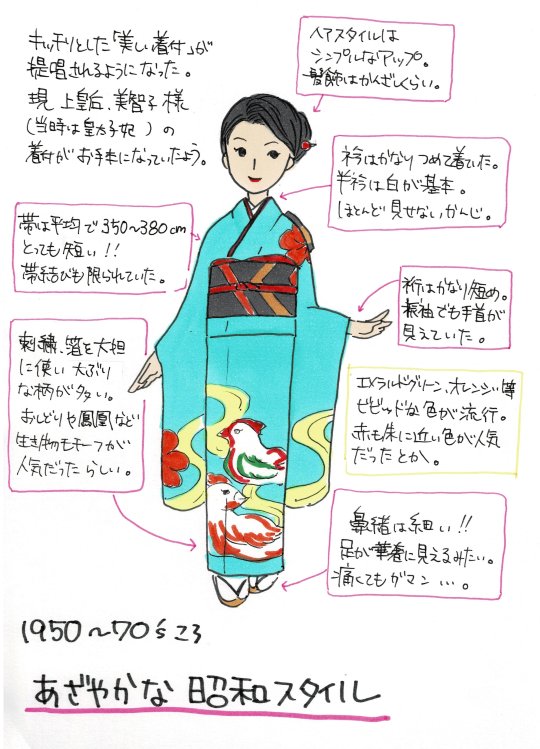

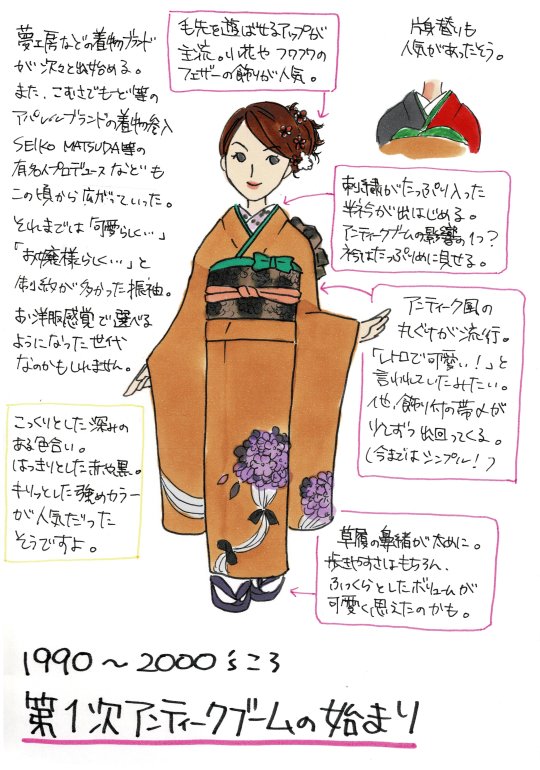
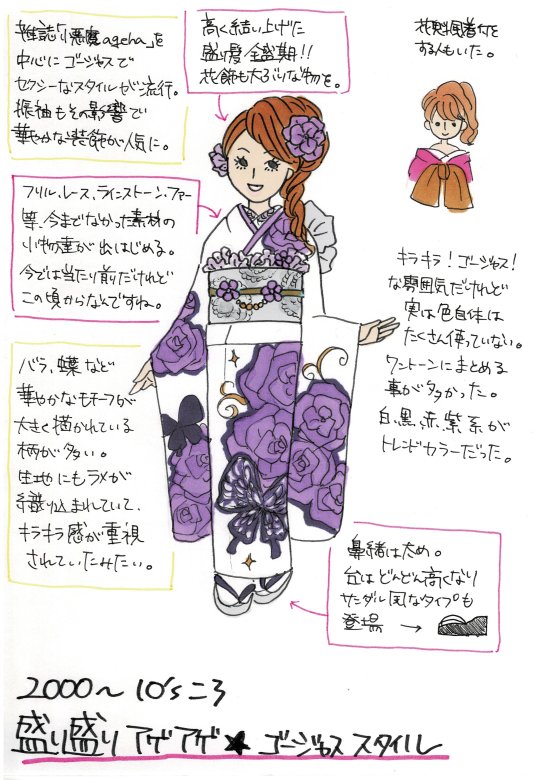

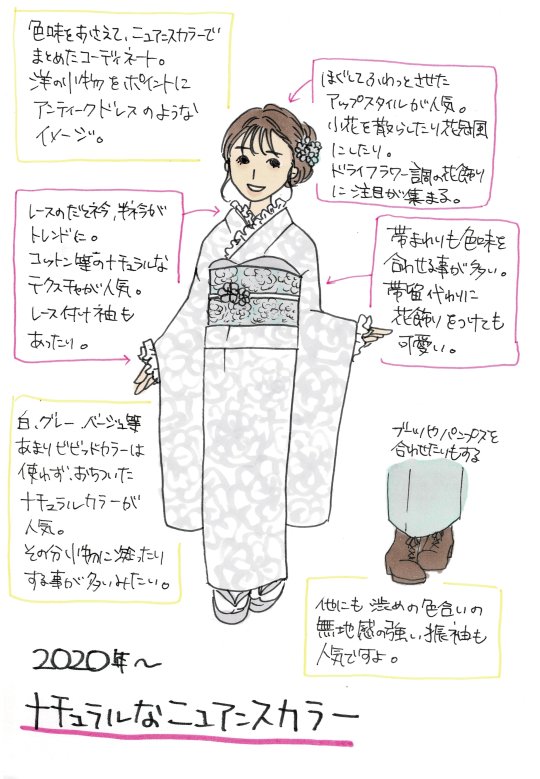
[Evolution of furisode fashion from the 1950′s to 2020′s], handy charts by shop KomonoHana. Please note that the trends shown and describe here are the most notable evolutions - that doesn’t mean everybody was following those trends to the T ;)
1950-1970′s - Showa style
After wwii, a new era began for kimono, trying to recover from harships of wartime. Prototype of modern Seijin no hi was held for the first time in 1946. The economic miracle made possible for ordinary households to own or at least rent furisode outfits, which were in the past mostly only affordable for wealthy families.
Style favored bold embroidery with gold foil etc, and vivid oranges and emerald greens were very popular colors.
New methods and rules for kitsuke/dressing appeared as many people didn’t have the knowledge/means to dress in traditional furisode attire as before:
=> Expensive and heavy maru obi fell out of fashion, and fukuro obi became the norm (only patterned on one side, they are cheaper and easier to produce).
=> Costly and cumbersome layered kimono called kasane also disappeared, replaced by decorative collar called date eri mimicing layers.
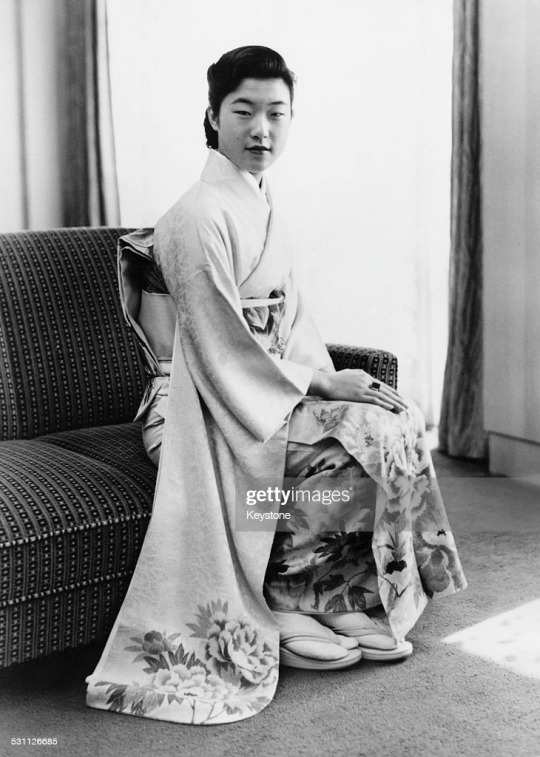
1980-1990′s - Bubble style
The economic bubble from that decade saw a big demand for consumer products. Same went for kimono items.
Demand for embroidery and gold foil decreased, but glossy rinzu (raised ground patterned fabric) was super popular. Small scattered patterns were a staple of the period.
Fukuro obi also became longer, making elaborated novelty belt knots possible (before that era, bunko, or fukura suzume for example were the norm).

1990-2000′s - Antique kimono boom
When the economic bubble finally burst, the amount of money spent for Seijin no hi furisode dramatically decreased.
Little by little, antique kimono became fashionable. One reason, beside obvious cost, might have been the huge popularity of Akina Nakamori's music video [DESIRE - Jônetsu]. In any case, antique/vintage kimono shops opened everywhere.
That decade liked deep, crisp ground colors. Because of the second hand popularity, patterns were often old fashioned, antique ones.
Ready to wear kimono -sometimes designed by Stars of the era- started to become available, with often the promised of being easily washable - something difficult to do with silk kimono.
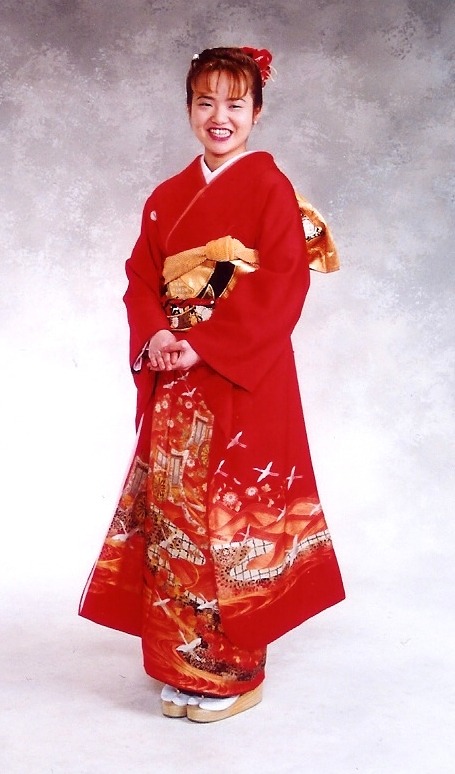
2000-2010′s - In your face! Ageha’s kimono
In reaction against to “old fashion” feeling of the past decade, style became more youthful and extravagant.
Gyaru magazine [Koakuma Ageha] made the hight ponytail fashionable, and that hairdo became a staple of that style, often embelished with large floral ornaments.
Contrasting colors like white, black, and purple were very popular. More is more was everywhere, with use of glitters, rhinestones, lace, frills, fur, pearls...
The “oiran” style also saw a trend, with furisode worn sexily off shoulder with obi belt knotted up front.
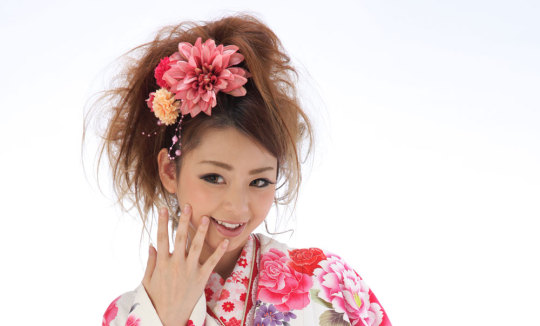
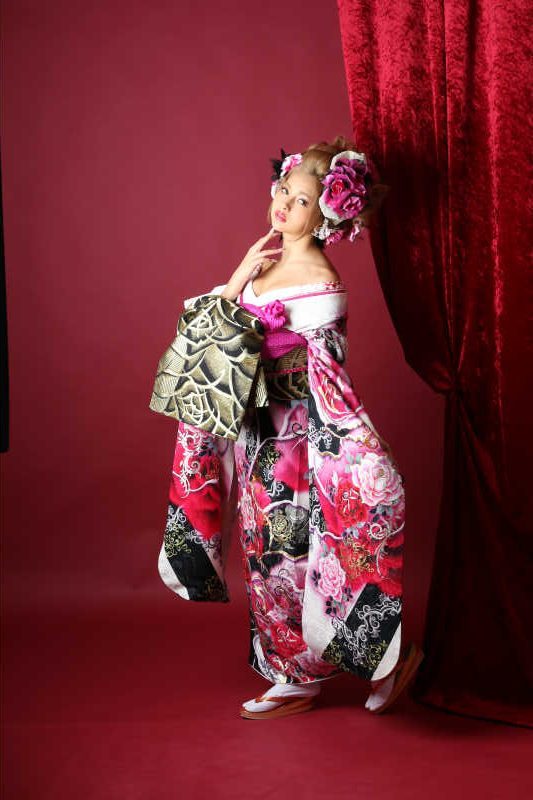
2010′s-2020′s - Between classic and modern
Furisode crazed fashion trends of the past decade became a bit more quiet, and offer diversified.
“Retro modern” furisode appeared, mixing reinterpreted traditional motifs and graphic/geometrical patterns. Colors tended to be really “pop”, not afraid to mix turquoise and bright pink for example.
On the other side of the spectrum, pastel colors were also in high demand.
Hairstyles returned to more classic buns, with notable fact that braids popularity rose.
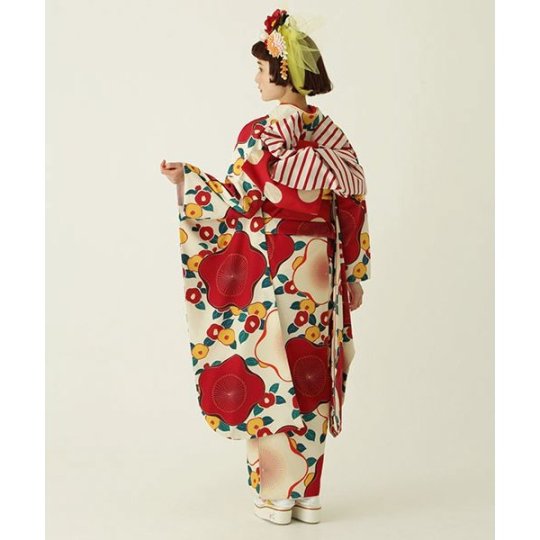
2020′s~ - Chic and Romantic
Reiwa era is still pretty young, but new trends are emerging nonetheless.
Light, natural colors are fashionable atm, such as light greys or beiges.
Busy patterns are also losing ground, as quiet, or even plain mujifurisode are becoming easier and easier to find.
Cute frilly accessories make a return, with lace, pearl, etc. It can be as headress, or for undershirt, or even gloves.
Western shoes are more and more considered acceptable.
Hairstyle are light and romantic, with loose buns sometimes decorated with dried flowers for example.
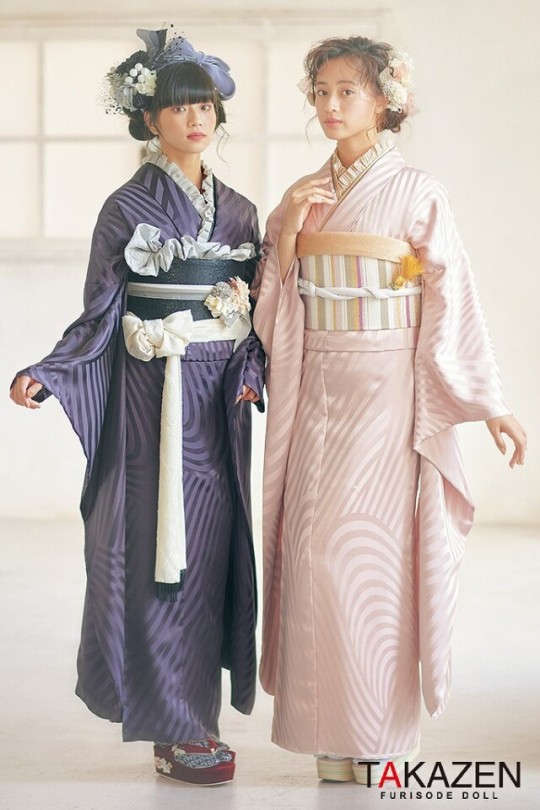
#japan#fashion#kimono#furisode#obi#history#fashion history#Showa era#economic bubble#gyaru#Retro modern#mujifurisode#iromuji furisode#振り袖#帯#着物
4K notes
·
View notes
Text
The look of... IV: Hakata/Fukuoka
Historical context
It is said that the first Geigi started working in Hakata in the middle of the Edo period (1750s). Osaka Geiko were invited to entertain in Nagasaki, but they were limited to staying 100 or less days in the city, so they temporarily worked in Hakata, before returning to Nagasaki again. Some of those settled permanently in Hakata, making them the first Hakata Geigi.
The first official date in the history of the Hakata hanamachi is 1889, when Hakata was merged into Fukuoka and Aioi Kenban 相生券番 was established. For those of you who don't know, a Kenban is an agency for Geigi, similar to an agency for other artists.
In 1897, Nakasu 中洲 Kenban and in 1901, Mizuchaya 水茶屋 Kenban were established. In the Taishô era (1912-1926), two more Kenban were established: Shin 新 ("new") Kenban and Minami 南 ("southern city") Kenban. In the Meiji and Taishô era, the Hakata hanamachi was flourishing and the number of Geigi exceeded 2000. In the early Shôwa period (1937-45), the maximum number of Geigi was 884.
During the second world war, the Kenban system was completely dissolved. After the war was over, only Nakasu and Mizuchaya Kenban picked up business again. Like all over the country, the interest in traditional culture dwindeled and the number of Geigi shrunk. In 1985, Nakasu and Mizuchaya Kenban were merged to form Hakata 博多 Kenban.
Currently (April 2022), there are four Jikata Geigi, nine Tachikata Geigi and two Hangyoku in the city.
The look of Fukuoka Maiko
Local term: Hangyoku
※ Hairstyle: Momoware Katsura
※ Kanzashi: Kushi, seasonal Maezashi and Daikan
※ Makeup: Oshiroi, both lips painted from the start
※ Kimono: Furisode with shoulder and sleeve tucks
※ Eri: red with white embroidery
※ Obi: Han-Darari
※ Obiage: flat, shibori (white, pink, red/white)/otherwise red with silver embroidery
※ Obijime: flat or round with 1 knot, no pocchiri
※ Footwear: Zôri


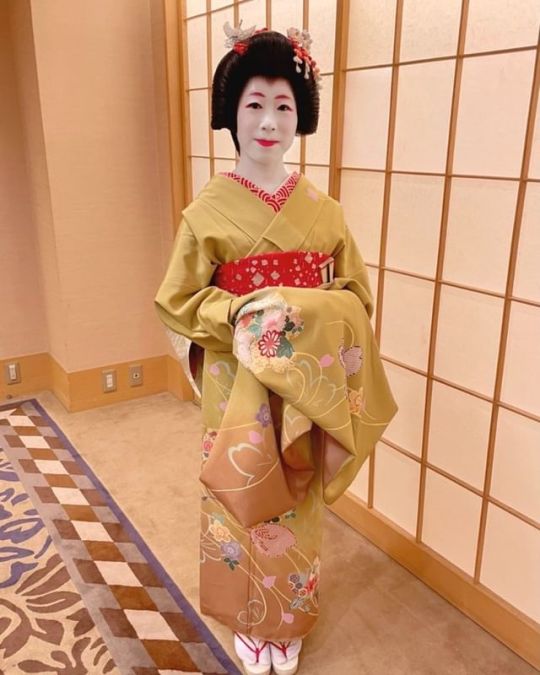


The look of Fukuoka Geiko
Local term: Geigi
※ Hairstyle: Geiko shimada Katsura
※ Kanzashi: Kushi, Bekko kogai in front and back, Maezashi
※ Makeup: Oshiroi
※ Kimono: Kuromontsuki Hikizuri, otherwise Hômongi
※ Eri: white
※ Obi: Yanagi musubi with Hikizuri, otherwise Taiko musubi
※ Obiage: always red with Kuromontsuki, otherwise white or light blue
※ Footwear: Zôri, Geta with white or blue Hanao

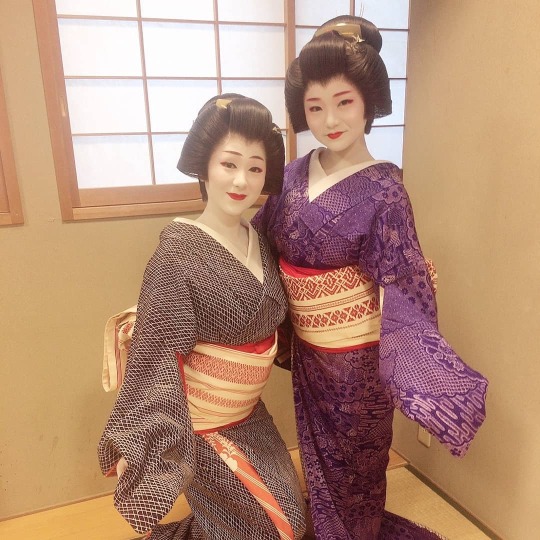

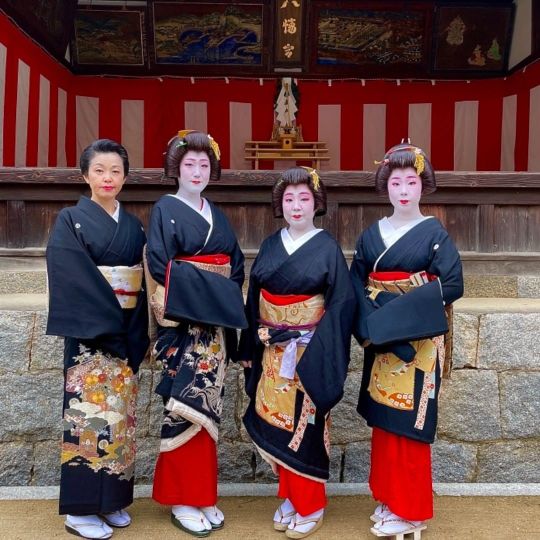

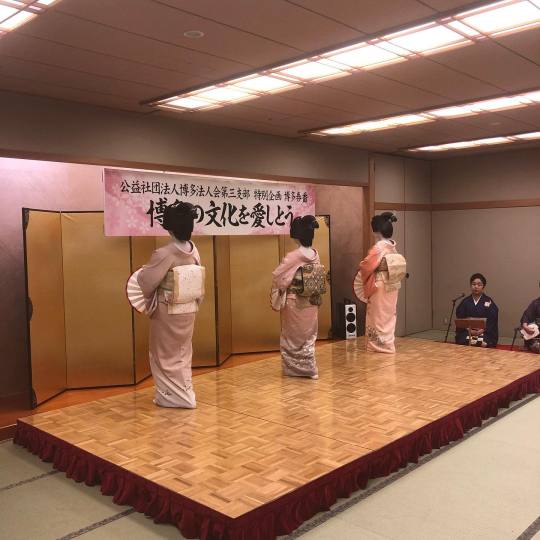
Notes
In some cities, Geigi are sorted by which Kenban they are registered at rather than in which Hanamachi they work. Apart from Fukuoka, you can see this system in Matsuyama. Hangyoku have been seen performing while wearing Iromuji or Hikizuri (the latter with Darari obi) too. Elderly Tachikata Geigi often wear the same, more simple, outfit like Jikata Geigi.

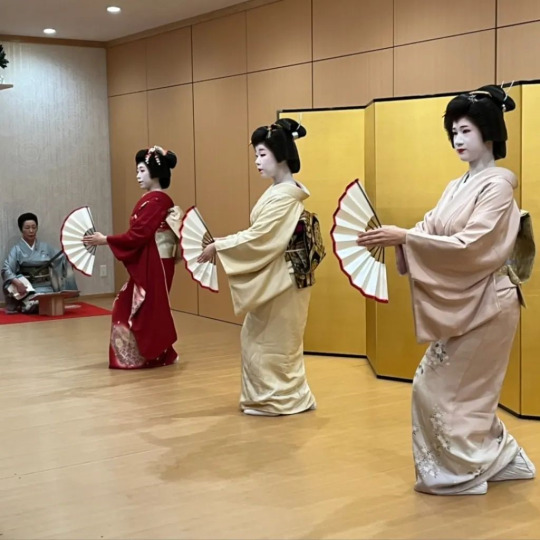
Sources
Layout by @geimaiko ♥
https://hakata-geinou.jp/img/request_en.pdf
http://hakatakenban.com/history/
https://en.wikipedia.org/wiki/Fukuoka#Formation_of_the_modern_city_(1889)
Pictures: Hangyoku dancing 2018, Nono, Reika and Kotone 2019, Nono and Kotone 2019, Hinazuru debut 2021, Hinazuru and Kochô 2021, Kochô debut 2022, Kuromontsuki with Hakata weave obi 2019, Shibori Hikizuri 2019, Wanoka debut 2020, New year 2021, Senior Geigi dancing (Umeka?) 2021, Obi showcase 2022, Koharu, Kochô and Hinazuru 2021, Hinazuru, Kochô and Reika dancing 2022
Original post from April 2022, last updated September 2023
#MG#fukuoka#kimono#geigi#geiko#geisha#maiko#hangyoku#nono#REIKA#Kotone#Hinazuru#Kocho#koharu#2018#2019#2020#2021#2022
34 notes
·
View notes
Note
Hi, I'm the anon who asked about the female kimono. I meant what are the types of kimono worn by women, ladies and girls?
YES. I LOVE this question! I was thinking of saving it until The Twelve Days of Fun (which are coming back again this year, by the way), but I didn't want you to wait another month for an answer so, here's a basic breakdown of kimono types worn by females:
Furisode (振袖)
Worn By: Unmarried Women and Girls
Formality: High
The iconic kimono known for its swinging sleeves, the furisode is worn to special occasions by unmarried women. The sleeves are long so as to attract a mate (I'm not making this up).
Tomesode (留袖)
Worn By: Married Women
Formality: Highest
Worn most often by the mother-of-the-bride and mother-of-the-groom at weddings. It's denoted by the presence of five kamon (family crests) and decoration only below the waist.
Houmongi (訪問着)
Worn By: Married Women
Formality: High
Translated as "Visiting Wear," the houmongi is worn to special occasions. Unlike a tomesode its patterns run across the garment and include patterns on the sleeves. It can have kamon present, but most often will not.
Tsukesage (付け下げ)
Worn By: Married Women
Formality: Medium
The houmongi's slightly subdued cousin, the tsukesage is often confused for houmongi by people who don't know how to tell the two apart. While a houmongi's pattern will flow across the entire kimono, the tsukesage's patterns will only stay within the haba (panels) and flow upwards.
Iromuji (色無地)
Worn By: Married and Unmarried Women
Formality: Medium
A plain colored kimono with no patterns and only the presence of kamon, it's slightly formal and can be worn out almost anywhere. People tend to shy away from them due to their lack of patterns though.
Komon (小紋)
Worn By: Married Women, Unmarried Women, and Girls
Formality: Everyday Wear
The komon, meaning "small pattern," is the casual, everyday kimono. It's hallmarked by its repeating patterns.
Yukata (浴衣)
Worn By: Married Women, Unmarried Women, and Girls
Formality: Bottom
The yukata is the least formal type of kimono. Worn in bath houses and at summer festivals, it's simple to put on and doesn't require an arsenal of accessories to wear. However, it's improper to wear one out and about unless it's the summer time, and even then you can't really wear it to many places.
50 notes
·
View notes
Photo
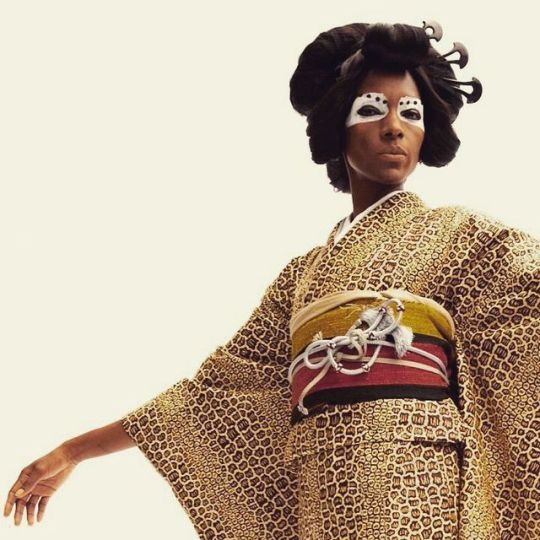
Beautiful #kimonos with printed materials by the #Cameroon-ian designer Serge Mouangue... If a Japanese or European did it weak minds would be shouting cultural appropriation, whatever that means... My culture is not an image or an object, it's a lifestyle that I live proudly and fully daily. I dont even know how anyone can appropriate it... Stop borrowing Americanist narratives that make no sense in African context. I blame BET, MTV and the colonial American entertainment for making Africans copy & paste what's not relevant to them. #SergeMouangue did a nice interview with @okayafrica, check it out... #Design #Fashion #Keisha #Kimono #Furisode #Homongi #Iromuji #Komon #EdoKomon #Mofuku #Tomosode #Irotomesode #Kurotomesode #Tsukesage #Uchikake #Susohiki
#sergemouangue#susohiki#furisode#homongi#keisha#mofuku#komon#edokomon#kimonos#kurotomesode#fashion#kimono#iromuji#design#uchikake#irotomesode#cameroon#tsukesage#tomosode
1 note
·
View note
Text
BODY/APPEARANCE TAG

Body
Long legs. Short legs. Average legs. Slender thighs. Thick thighs. Muscular thighs. Skinny arms. Soft arms. Muscular arms. Toned stomach. Flat stomach. Flabby Stomach. Soft stomach. Six-pack. Beer belly. Lean frame. Slender frame. Beefy/muscular frame. Voluptuous frame. Petite frame (5 ft 4 or shorter). Lanky frame. Short nails. Long nails. Manicured nails. Dirty nails. Flat ass. Toned ass. Bubble butt.Thick ass. Small waist. Thick waist. Narrow hips. Average hips. Wide hips. Big feet. Average feet. Small feet. Soft feet. Slender feet. Calloused feet. Calloused hands. Soft hands. Big hands. Average hands. Small hands. Long fingers. Short fingers. Average fingers. Broad shoulder. Underweight. Average weight. Overweight.
Height
Shorter than 140 cm. 141 cm-150 cm. 151 cm to 160 cm. 161 cm to 170 cm. 171 cm to 180cm. 181 cm to 190 cm. 191 cm to 2m. Taller than 2 m.
Skin
Pale. Fair. Rosy. Olive. Dark. Tanned. Blotchy. Smooth. Acne. Dry. Greasy. Freckled. Scarred.
Eyes
Small. Large. Average. Grey. Brown. Black. Blue. Red. Green. Gold. Hazel. Doe-eyed.Almond. Close-set. Wide-set. Squinty. Monolid. Heavy eyelids. Upturned. Downturned.
Hair
Thin. Thick. Fine. Normal. Greasy. Dry. Soft. Shiny. Curly. Frizzy. Wild. Unruly. Straight. Smooth. Wavy. Floppy. Cropped. Pixie-cut. Short. Shoulder length. Back length. Waist length. Floor length. Buzz cut. Bald. Jaw length. Mohawk. White. Platinum blonde. Golden blonde. Dirty blonde. Ombre. Light brown. Mouse brown. Chestnut brown. Golden brown.Chocolate brown. Dark brown ( natural ). Jet black. Ginger. Auburn. Dyed red. Dyed any “unnatural color”. Streaked. Thin eyebrows. Average eyebrows. Thick eyebrows.
Tattoos/piercings
Full sleeve. Thigh tattoo. Shin tattoo. Wrist tattoo. Hand/finger tattoo. Foot tattoo. Neck tattoo. Face tattoo. Chest tattoo. One tattoo. A few here and there. Multiple. No tattoo. Monroe piercing. Nose piercing. Septum. Nipple piercing(s). Genital piercing(s). Industrial piercings.Earlobe piercing. Prince Albert piercing. Eyebrow piercing(s). Tongue piercing(s). Lip piercing(s). Tragus piercing. Angel bites. Labret. Stretches out ears. Navel piercing. Inverse navel piercing. Cheek piercing(s). Smiley. Nape piercing(s). No piercings.
Cosmetics
Light eyeliner. Heavy eyeliner. Cat eyes. Mascara. Fake eyelashes. Matte lipstick.Regular lipstick. Lipgloss. Red lips. Pink lips. Dark lips. Bronzer. Highlighter. Eyeshadow. Neutral eyeshadow. Smoky eyes. Colorful eyeshadow. Blush. Lipliner.Light contouring. Heavy contouring. Powder. Matte foundation. Shiny foundation. Concealer. Wears make up regularly.Wears it from time to time. Never wears make-up.
Scent
Floral. Fruity. Perfumes. Aftershave. Cocoa. Moisturizer. Natural soap. Shampoo. Cigarettes. Leather. Sweat. Food. Incense. Marijuana. Cologne. Whiskey. Wine. Fried food. Blood. Fire. Metal. Rain. Grass. Ocean. Autumn leaves. Baked bread. Freshly baked cookies. Smoke. Campfire. Lavender. Trees. Pumpkin Pie. Musk. Rose. Gingerbread. Peppermint. Oak. Honey. Lemon. Vanilla. Coffee Cake. Mint. Raw hyde.
Clothes
Jeans. Tight pants. Overknee socks. Tights. Leggings. Yoga pants. Pencil skirt. Tight skirt. Loose skirt. Tight/formfitting dress. Cardigans. Blouse. Button up shirt. Band-T-shirt. Sports-T-shirt. Sweatpants. Tanktop. Cut off t-shirt. Designer. High street. Online stores. Thrift. Lingerie. Long skirt. Miniskirt. Maxidress. Sun dress. Tie. Tuxedo. Cocktail dress. Highslit dress/skirt. T-shirt. Loose clothing. Tight clothing. Jean shorts. Sweater. Sweater vest. Khaki pants. Suit. Hoodie. Harem pants. Basketball shorts. Boxers. Briefs. Thong. Hotpants. Hipster panties. Bra. Sports bra. Crop top. Corset. Ballerina skirt. Leotard. Polka dot. Stripes. Glitter. Silk. Lace. Leather. Velvet. Chemise. Patterns. Florals. Neon colors. Pastels. Plaid. Black. Dark colors. Fur. Faux fur. Kimono. Komon. Furisode. Tomesode. Yukata. Iromuji.
Shoes
Sneakers. Slip-ons. Flats. Slippers. Sandals. High heels. Kitten heels. Ankle boots.Combat boots. Boots. Cowboy boots. Knee-high. Platforms. Stripper heels. Bare feet. Loafers.
1 note
·
View note
Photo
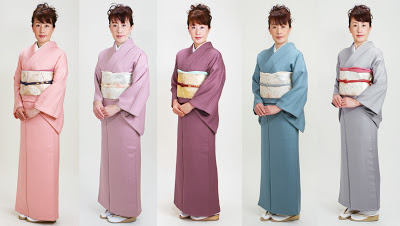
Learn About Iromuji Kimono for Tea Ceremony
We found this wonderful blog post discussing in length about tea ceremony kimono. Click here to read the whole blog post.
“The most common tones for iromuji are subdued, giving this kind of kimono a dignified and mature feel (flashy colors are related to youth in kimono aesthetics). Since it's very discrete, iromuji is often worn during the japanese tea ceremony (cha-no-yu), that pursues an aesthetics of simplicity. Iromuji allows the focus to be on the ceremony itself (a colorful furisode, for example, would be a too bright distraction, as well as too formal, in most types of tea ceremony).”
#iromuji#kimono#teaceremony#japaneseteaceremony#iromujikimono#womanskimono#vintagekimono#allaboutkimono#ilovekimono#learnaboutkimono
3 notes
·
View notes
Text
History of Japan during Edo period
Japan always was a country that I loved to know more about. When I was ten years old I started karate, since then I become interested to know about this country and culture more. For knowing a culture, the best thing is to know the history of that culture and country. I was very lucky that school offered Japanese study that I had a chance to learn and experience Japanese history and culture. Japan has a long history like other Asian countries. I mention the periods in Japanese History. Early Japan (until 710), Nara and Heian Periods (710-1192),Kamakura Period (1192-1333),Muromachi Period (1338-1573), Azuchi-Momoyama Period (1573-1603),Edo Period (1603-1868),Meiji Period (1868-1912),Taisho and Early Showa Period (1912-1945),Postwar Period (since 1945). My main focus is Edo period in this blog. During my trip I visited the Edo-Tokyo museum that helped me a lot to have a better understanding about Edo period and after that in Japan. It was very fascinating, but I will mention some of interesting part that catch my eye.
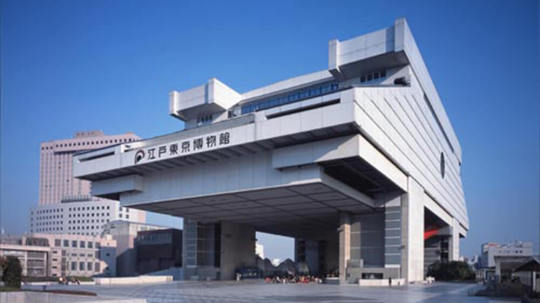
Isolation period :
Edo period was the period of isolation, in this period Japan was ruled by the Tokugawa family. About two century Japan close the door to other countries, no one can enter to Japan and no one could leave Japan to other countries to reduce foreigners’ influences. Exceptions were made for trade with the China, Korea, and Dutch, which was strictly controlled. Japan made an artificial island Dejima in Nagasaki to do their trade with these countries. Edo period was very important in my opinion. Closing the door to other countries for that long made japan what is today and how different is from other country and culture today. Japan is an amazing country to visit for people like to see different culture and are open to new adventure .
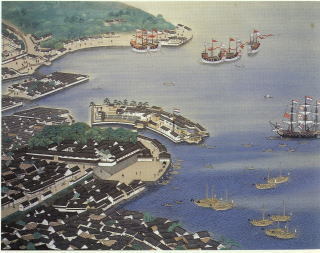
#Dejima , port that trade too a place during Edo period

The Great fire of Meireki :
The great fire of Meireki was one the three major fires during Edo period. The great fire of Meireki that knows as Furisode fire burned down 60% to 70% of Edo (Tokyo) city. It took about two years to rebuild the city. Fire was an important element during that time, was used for cooking, lighting which was the cause for fire during that time. At the same time most of houses, buildings were made of wood and paper so that helped the fire to spread out.
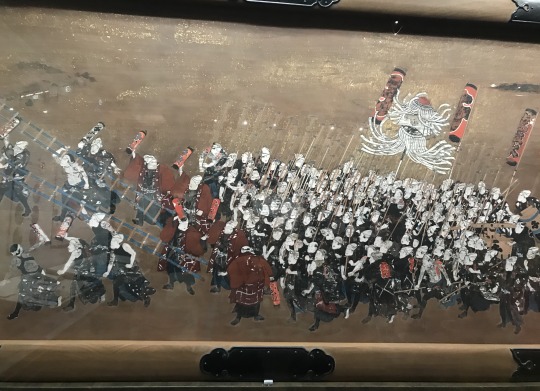
#fire
Some interesting fact about sushi :
Sushi was imported from China, which fish was salted and wrapped in fermented rice. However, during Edo period Japan created a new type of sushi, known as Haya-Zushi or Nigirizushi. Haya-zushi made of fresh fish and vinegar tasted rice and prepared by grasp of palm. Haya means quick and Haya-Zushi become sort of fast food during Edo period. Food stalls was getting popular during that time and so many single men would buy sushi from food stall, so sushi become popular food among people. The sushi looked much bigger compare to sushi in these days .
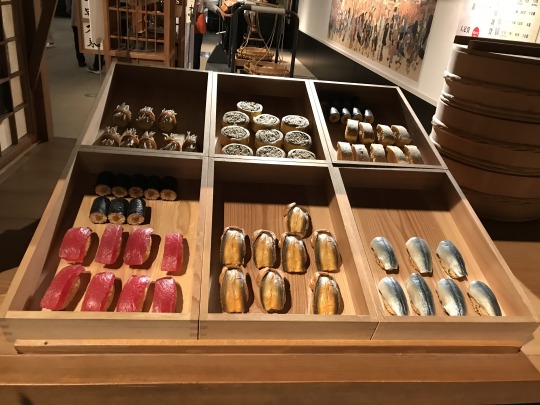
#sushi during Edo period

#food stall

#me trying to sale fish in Edo museum ;)
Kabuki:
Kabuki is the traditional Japanese form of theater that was created during Edo period. It is one of three major classical theater in japan (Noh, Bunraku, and Kabuki). Kabuki is Japanese traditional drama with singing and dancing in in stylized manner. Actors move slowly, shout load and try to attract audience. Kabuki used to be acted only by women until become restricted and banned for while, since then men only can perform Kabuki. Male Kabuki actors play female roles which called onnagata.

#kabuki

# Kabuki (dance)
Kimono :
A kimono translated as “the thing worn” is Japanese traditional garment which is look like T shape. Kimono been existed since early centuries, but it wasn’t until Edo period that being used as a clothing. It was first yukata which was used as a robe after shower. Japanese priest worn yukata after bath, in earlier centuries only priest could used yukata not normal people. It was during Edo period that Kimono or Yukata become so popular and fashionable and everyone could wear kimono. Now days Japanese people don’t wear kimono in everyday life, they wear kimono for special occasion such as wedding, funeral, tea ceremony. Did you know that different styles of kimono are worn during different occasion? The kimono worn during tea ceremony is different than kimono worn during wedding. Married women wear different type of kimono than single women.

# Kimono Fashion Show In Kyoto
Furisode is type of kimono that worn by unmarried women, has long sleeves, usually very colorful. The longer the sleeve is, the more formal it is. Usually unmarried women worn Furisode in coming age ceremony or wedding.
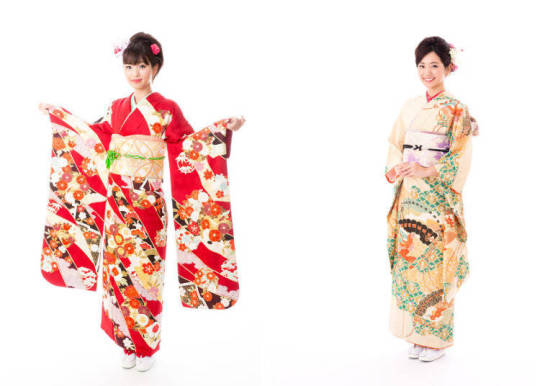
#Furisode
Komon are worn by married and unmarried women, they have a small and repeated pattern covering entire kimono, are most informal silk kimono.

#Komon
Iromuji are single coloured kimono without pattern and are worn by married and unmarried women usually for tea ceremony.

#Iromuji
Mofuku is the mourning dress for both women and men, a complete plain back silk with five crests over white undergarments.

#Mufuko
We had a chance during out trip to japan worn yukata, was an amazing experience. Sweet lady helped me to wear it, wasn’t easy for first time trying. I love how colorful and different are from western clothing. I felt and more connected to Japanese by wearing yukata.

#me trying yukata

# the most I felt Japanese ;)
The last that I like to mention that was very interesting to me and I have never heard of it is about balloon bomb, which is after Edo period and during world war two.
Balloon Bomb :
In Edo museum one of the most interesting thing catch my eye that I had never heard of was the Balloon Bomb. The balloon bomb was developed by the Japanese army to attach the American mainland during world war two. It was a weapon with a bomb or fire bomb that was hung from a flying balloon. These balloons were 10 meters in diameter that was made by sticking Japanese paper together with konnyaku paste. This weapon was developed by the army behind doors, it was manufactured at army facilities and other places with large spaces such as Japanese theater, the Tokyo Takarazuka theater, and the hall of sumo in Tokyo. Many female students helped to make these balloons. 9000 of these balloons were completed and were launched from November 1944 to April 1945, from launch base on the pacific coast. Of these 9000 balloons about 300 reached the American continent. The balloon didn’t have any major consequences.

History of Japan is quite fascinating. I have had an opportunity to familiarize myself within the Edo timeline, an era where Japan had closed its door from all foreign culture only to structure its own culture and value. This was an amazing experience and I have learned more about the history of Japan prior to the Edo period which I would love to write in my next blog.
2 notes
·
View notes
Note
I love your blog! Do you have any kimono yourself? And if so, where did you get them and what do they look like?
Hello, thanks for the ask!
About 8 years ago, I met Mod2, who was taking Koto lessons at the time here in Nagoya, and she introduced me to kimono kitsuke. For the nest 2 years she and I practiced kimono regularly, wearing them on weekends and shopping for used kimono at various shops in Nagoya. At the time my collection was at its largest (about 25-30 kimono and a similar number of obi), and also helped friends dress in yukata and kimono, so needed many to loan out-- but later, I whittled it down to just several pieces of male and female kimono each. Now I keep some iromuji and some komon kimono for my partner, one furisode, and 3 or 4 male kimono. They’re very reasonably priced if you can get them in the used shops, the trouble is storage space! >_
27 notes
·
View notes
Text
Himeko - Refs - P2

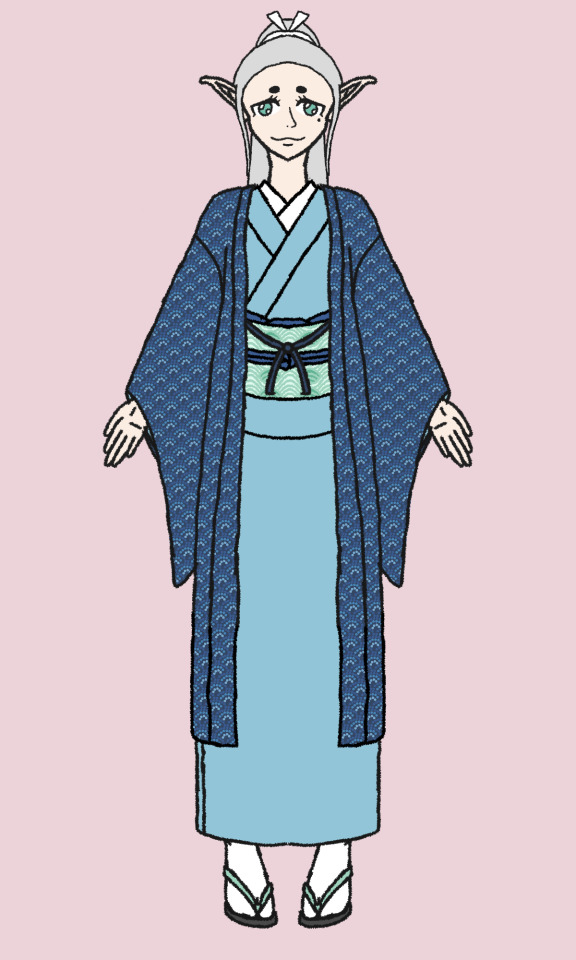
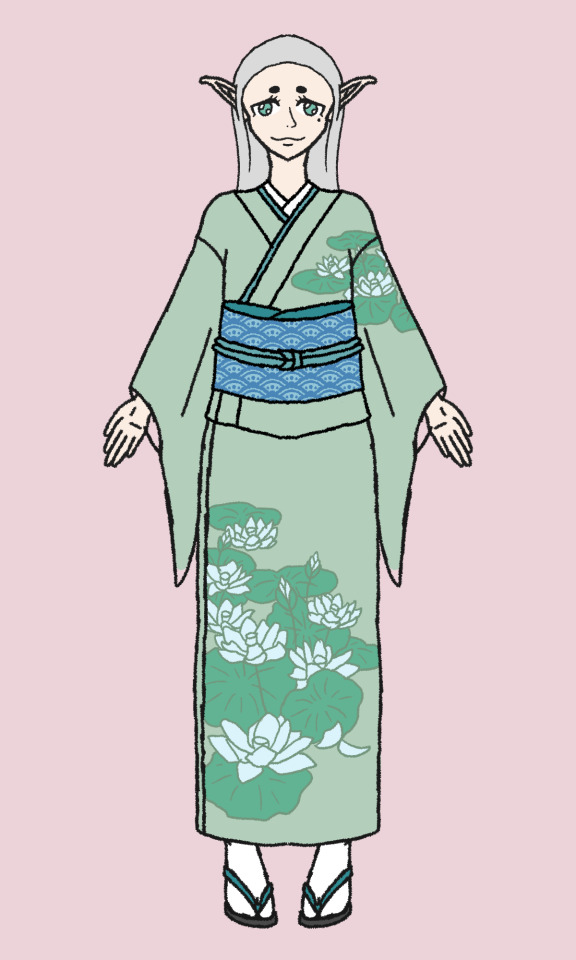
Left:
Komon:
Use:
- Casual Wear
- Travel Wear
- Worn with Geta sandals
- is worn from the Edo period up to modern day
Middle:
Iromuji & Haori:
Use:
- Semi-Formal Wear
- Party Wear
- Worn with Zori sandals
- is worn from the Edo period up to modern day
Right:
Tsukesage:
Use:
- Semi-Formal Wear
- Date Wear
- Party Wear
- Worn with Geta sandals
- is worn from the Edo period up to modern day



Left:
Houmongi:
Use:
- Formal Wear
- Date Outfit
- Party Outfit
- Worn with Zori sandles
- is worn from the Edo period up to modern day
Middle:
Furisode:
Use:
- Formal Wear
- Date Outfit
- Party Outfit
- Festival Outfit
- Worn with Geta sandles
- is worn from the Edo period up to modern day
Right:
Irotomesode:
Use:
- Formal Wear
- Party Outfit
- Worn with Zori sandles
- is worn from the Edo period up to modern day
#original#original character#ocs#oc#oc character#original design#character design#character art#outfit design#fae#faerie#fae folk#fairies#fairy#Himeko
1 note
·
View note
Note
Hai, First of all; Beautiful tumbler page!! The question i like to ask is; Is anything known of different traditions of Geiki and Maiko outside of Kyoto? Like the Shachihoko dance of Osaka Geisha, or ( in Pontocho, Kyoto), the different hairstyles of Maiko reaching the Erikae?
Hi and thanks!
The Sachihoko dance is a trademark of Nagoya, but they do it in Ôsaka (and Kyoto) as well!
Some examples I can think of:
- in Nara, Sakkô Hikizuri is almost completely black with red lining
- in Gifu, when Maiko entertain on boats, their Obi is tied up and resembles the “ya giccha musubi”, so it doesn’t get in the way.
- the trademark of Ôsaka Maiko is the Ya giccha musubi
- Akita had no Maiko for an undisclosed period of time, until three of them debuted in 2014. Their look changed a lot and it seems that they have finally settled to their unique style in Autumn 2018.
- in Fukuoka, the Hangyoku usually wear Momoware wigs, Furisode and Handara musubi. At certain events, Fukuoka Hangyoku wear Iromuji+Handara musubi or Hikizuri+Darari musubi like Kyoto Maiko. Kanzashi wise, they always wear a Kushi intead of a flower Katsuyama
- Furisode-san in Niigata wear only two different types of Obiage: 1. pink with white waves, 2. red with white flowers. The pattern of the Obiage also always matches the pattern of the Eri. It’s a seasonality thing.
- in Sapporo, all Geiko wear Tsubushi shimada wigs, which is a hairstyle for senior Geiko in other hanamachi. Similar to Gion Kobu, Maiko tie their Obiage in the last month of their apprenticeship.
- in Tokushima, Geiko and Maiko often wear matching Hikizuri/Furisode. Maiko’s Obi are tied as Fukura-suzume or Bunko musubi, which is not worn by other Maiko/Hangyoku. Geiko wear identical Kuromontsuki and pair them with identical golden obi.
- in Tokyo, each Hanamachi has a very distinct style; opposed to a certain uniformity you can find in Kyoto. Senior Geisha in Asakusa wear Tsunodashi musubi as their daily Obi style, Hangyoku in Asakusa hardly ever style their own hair when at work.
Hachioji Hangyoku don't wear wigs. Their hairstyle is Ofuku and it looks a bit different compared with Kyoto’s Ofuku. Their seasonal flower kanzashi change around the 20th of each month and not at the beginning.
In Mukojima, they have more Kanzashi variety than any other hanamachi. Mukojima Hangyoku can choose if they want to wear a wig or have their own hair styled. The "own hair" Momoware looks a bit different from behind than the Momoware of other cities. Senior Hangyoku can have their wigs styled as Yuiwata. All Mukojima Geisha wear Hômongi for work and their only Hikizuri are Iro- and Kuromontsuki.
Shinbashi never has a lot of Hangyoku, so it’s a bit hard to observe their style. Similar to Asakusa, they wear a Momoware-wig almost every day. But during the Azuma Odori, they will have their own hair styled.
- in Yûzawa, Maiko look very much like Kyoto’s Maiko, but wear wigs instead of having their own hair styled. However, from 2020 onwards, the single Maiko active has had her own hair styled the entire year, bringing her even closer to the typical Kyoto Maiko look.
That’s all, folks! (Last updated April 2021)
#MG#asks#Nara#Gifu#osaka#akita#fukuoka#niigata#sapporo#tokushima#Tokyo#Asakusa#hachioji#mukojima#shinbashi#yuzawa
44 notes
·
View notes
Note
Is the formality of a kimono based on its fabric or style? Can you use a cotton iromuji for daily wear and a silk komon for formal wear? Will a polyester furisode be considered inferior to a silk tsukesage? How strict are these kimono rankings
Usually material doesn’t come into play when referring to formality of garments as the higher you go the higher the quality of garments you encounter. A komon is still a komon no matter what it’s made out of, so it can never be used as formal wear. Polyester is almost impossible to tell apart from silk unless you’re really good at spotting the differences (and even then it can be hard), so having a furisode made out of polyester instead of silk also isn’t an issue when it comes to its formality. So, always go for the type of kimono and not its material when determining its formality ^^
13 notes
·
View notes